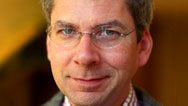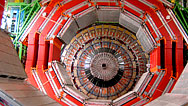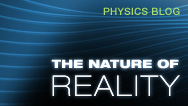CERN
- Posted 07.10.07
- NOVA scienceNOW
(This video is no longer available for streaming.) Explore the construction of the mother of all particle accelerators: the Large Hadron Collider at CERN, the international particle physics lab near Geneva, Switzerland. In this video, physicist David Wark reports on the ambitious goals of this 16-mile-long circular racetrack. Designed to smash protons together at near-light speed, CERN promises astonishing new discoveries about matter.
Transcript
CERN
PBS Airdate: July 10, 2007
NEIL DEGRASSE TYSON: In the movies, crazy scientists who build time machines are always obsessing about power, like it takes so many jiggawatts of electricity to get the thing to work.
Well, a bunch of real scientists have been working for years on one giant experiment, trying to create exotic particles that haven't existed in the universe for 14 billion years, back to the Big Bang itself.
Physicist and correspondent David Wark reports that, in a way, it's a giant time machine. Just like in the movies, it's all about energy.
DAVE WARK: (Correspondent): You'd never guess that, hidden beneath these French mountains, an army of workers is underground, constructing the biggest and most complex machine on Earth.
It's a project that's got physicists around the world brimming with anticipation.
PETER FISHER: It's a big step, this is a big time.
MEENAKSHI NARAIN: We may find things which nobody has ever thought of, or told us before.
STEVE AHLEN (Boston University): It's a real adventure because we don't know if it's going to work.
DAVE WARK: The goal of this giant construction project is nothing less than to find the basic building blocks of the universe.
MEENAKSHI NARAIN: The basic quest of particle physics is, "What is the world made of? Do we know everything? Do we know all the constituents of matter? Do we have them all?"
DAVE WARK: Scientists have already found a whole carnival of subatomic particles that make up the universe.
MEENAKSHI NARAIN: List some names.
STEVE AHLEN: Matter as we know it today...
PETER FISHER: There are protons, neutrons. That's what we're made of.
MEENAKSHI NARAIN: The top quark...
STEVE AHLEN: ...bottom quark
MEENAKSHI NARAIN: The up...
STEVE AHLEN: ...and the down quarks.
MEENAKSHI NARAIN: ...the charm quark, the strange quark...
STEVE AHLEN: There was a time when we just named everything something silly.
PETER FISHER: There are pions, kaons...
MEENAKSHI NARAIN: ...W-bosons, Z-bosons.
PETER FISHER: ...five different upsilon particles...lambdas...
STEVE AHLEN: ...gluons for the strong force...
PETER FISHER: ...omegas, sigmas.
MEENAKSHI NARAIN: ...muons.
STEVE AHLEN: Who ordered that?
PETER FISHER: And my favorite particle is the tau.
DAVE WARK: This panoply of particles is called The Standard Model, and it's our best picture of what the universe is made of.
But as dazzling as it is, we know that the carnival is incomplete. There have to be other hidden particles out there, and we need a new experiment to find them.
Normally physicists don't get to ride in helicopters, but today we want to see the world's largest experiment, and up here's really the only place you can get a sense of the scale.
Below me is the construction site at CERN, a particle physics lab. The new experiment is so big it stretches from the mountains in France, across the border, to the Geneva Airport in Switzerland. That's because the main part consists of a circular tunnel, 16 miles around. The tunnel is home to the world's biggest, most powerful particle accelerator ever, called the Large Hadron Collider or LHC. Because it's so big, LHC will let us probe deeper into the stuff of the universe than we've ever gone before.
This tunnel is being filled with giant electro-magnets, and, in fact, you can see some of them on the ground right there.
This is my stop.
Each tubular magnet costs close to a million dollars, and the LHC will need more than 1,600 of them.
So what is this?
MARTA BAJKO (Accelerator Technology Group, CERN): This is the magnet; this is the magnet which is inside this big blue tube.
DAVE WARK: The magnets are designed to keep those tiny parts of an atom called protons flowing in a narrow beam through the tunnel. When they are all connected together into a ring, the magnets will create a 16-mile racetrack for protons.
In the ring, the powerful magnetic fields force the protons to go round in a circle, and each time they go round they get a little kick from an electric field, so they go faster and faster until, eventually, they are traveling almost at the speed of light.
MARTA BAJKO: In fact, the particles, they are traveling in these two tubes. In one of the tubes the particles are traveling in one direction, in the other tube in the opposite direction.
DAVE WARK: So there's actually two beams of particles, going in opposite directions?
MARTA BAJKO: Exactly. Yes.
DAVE WARK: One beam going one way and one beam going the other way. And there are two beams because you are going to collide them?
MARTA BAJKO: Exactly.
DAVE WARK: This is a technique that's familiar to physicists. A proton traveling close to the speed of light, although absolutely tiny, will carry a lot of energy. Two of them traveling in opposite directions will carry twice the energy. Make them collide and most of that energy can be released in a tiny, but powerful explosion.
With enough energy, the explosion should create fundamental particles that we've never seen before. If that happens, it'll be in a tiny region smack in the center of a vast underground cavern.
This is one of the four places around the ring where the two beams will actually collide. One beam will come from a tiny beam pipe, from the middle of that hole over there, and fly over my head. The second beam comes through that hole over there, and high up over my head, in the middle of the cavity, the two protons will collide.
Now, we're colliding two tiny little protons. Why do we need this vast cavern to find out what happens? Well, in order to detect if any new particles have been created in a collision, researchers have to fill this cavern with some of the most complex scientific instruments ever created.
The one here is called CMS.
This is one end of the vast CMS detector; the whole detector consists of a series of these plates, each one of which is instrumented with thousands of detectors you can see up here. As we move down we see a large number of these which will all be slid together to make the final detector. No space at all is wasted. This big hole looks like a hole in the detector, but in fact the hole in those detectors is filled by these detectors.
Different detectors pick up different kinds of particles, and sandwiched together they'll create a single enormous cylinder which completely surrounds the point where the protons collide. That's important because, as the particles fly away from the collision through the detector, they will leave tracks which form a kind of fingerprint.
It's by analyzing these fingerprints that scientists should be able to tell if a new particle was briefly created at the moment of collision.
PETER FISHER: That's why the experiments are hugely complicated. They have to identify all the things that come out of two protons that hit.
STEVE AHLEN: The LHC experiments are by far the most difficult that have ever been done in high energy physics, and maybe any experiment.
DAVE WARK: In fact, the experiments are so complicated it takes physicists from dozens of countries to pull them off.
LHC TEAM MEMBER 1: I'm from Switzerland.
LHC TEAM MEMBER 2: I'm from Belgium.
LHC TEAM MEMBER 3: ...sono Italiana, Toscana.
LHC TEAM MEMBER 4: ...France.
LHC TEAM MEMBER 5: ...Japan.
LHC TEAM MEMBER 6: ...Austin, Texas.
LHC TEAM MEMBER 7: ...Russian.
LHC TEAM MEMBER 8: ...UK.
LHC TEAM MEMBER 9: ...California.
LHC TEAM MEMBER 10: I'm from Senegal.
LHC TEAM MEMBER 11: ...New Jersey.
LHC TEAM MEMBER 12: ...Colombia.
LHC TEAM MEMBER 13: ...India, from Bombay.
LHC TEAM MEMBER 14: ...from Germany.
LHC TEAM MEMBER 15: ...Argentina.
LHC TEAM MEMBER 16: I'm from Togo, West Africa.
LHC TEAM MEMBER 17: I'm from Brazil.
LHC TEAM MEMBER 18: And I'm from the Czech Republic.
JIM BENSINGER (Brandeis University): You meet people from all over the world. You talk with them; you get their point of view; you exchange ideas. They all tend to be physicists, so it's not that wide, but I find that's exciting. If the rest of the world worked the way we do, we'd have far fewer problems.
DAVE WARK: One problem they do have is analyzing the vast mountain of data that the LHC is going to produce, because, when it's running, it'll create about a billion proton collisions a second. And it'll be running 24/7.
TEJINDER VIRDEE: We get 40 million megabytes of data created every second.
DAVE WARK: Forty million megabytes, 40,000 gigabytes, or that would be 1,000 large discs for your home computer every second.
TEJINDER VIRDEE: Yes, it's mind boggling. The amount of data that we are generating in one year is 10 times bigger than all the World-Wide-Web-stored data.
DAVE WARK: In fact, the World Wide Web was invented here at CERN to analyze the results of earlier experiments.
But the LHC has so much more data, it will need the power of the Web's successor, something called "the GRID." Using millions of computers around the world, the GRID will turn high-speed computing power into just another commodity, like music or telephone service, that, someday soon, everyone will be able to buy online.
It's all part of a quest to understand the world in minute detail.
One mystery scientists would love to solve is why some of the particles now whizzing around the universe have mass.
STEVE AHLEN: The fact is, from a physicist's point of view, from a philosopher's point of view, from an observational point of view, mass is actually quite mysterious.
DAVE WARK: In our best theory of matter, the Standard Model, all the really fundamental particles are like photons—the particles of light—in that they have no intrinsic mass.
But we know that objects in the real world have mass, and scientists know that particles like protons and electrons also have mass. So where does that mass come from?
PETER FISHER: Why do particles have different masses? And why do they have mass at all? Mass is not something that emerges naturally from a theory.
MEENAKSHI NARAIN: We basically do not understand why some particles got mass and others didn't. What happened? What gave mass?
DAVE WARK: The leading idea for explaining mass is something called the Higgs field, a field which we believe pervades all of space and which the fundamental particles interact with.
The Higgs field is like cosmic cotton candy; it sticks to everything. And, according to this idea, it's actually that stickiness that gives particles their mass.
If the Higgs field, along with a Higgs particle, really exists, then the Large Hadron Collider should find it. And that would be a triumph for the Standard Model.
But since the LHC will take the particle hunt to a whole new level, many physicists are hoping it will uncover types of matter we've never even dreamed of.
MEENAKSHI NARAIN: The best case, in my mind: we do not find the Higgs particle, and we find a whole new set of new particles.
STEVE AHLEN: I don't really care what we find. You know, I just want to go off there and look at something and see something no one's ever seen before. That's what motivates me.
PETER FISHER: It's just a voyage of discovery. It's looking out into the cosmos and trying to see where we fit in it.
Credits
CERN
- Edited by
- David Fairhead & Dan McCabe
- Written and Produced by
- David Sington and Julia Cort
- Directed by
- David Sington
NOVA scienceNOW
- Executive Producer
- Samuel Fine
- Executive Editor
- Neil deGrasse Tyson
- Senior Series Producer
- Vincent Liota
- Supervising Producer
- Stephen Sweigart
- Editorial Producer
- Julia Cort
- Development Producer
- Vinita Mehta
- Senior Editor
- David Chmura
- Post Production Supervisor
- Win Rosenfeld
- Unit Manager
- Candace White
- Associate Producers
- Sarah Kinsella
- Anthony Manupelli
- Shimona Shahi
- Production Assistant
- Alison Snyder
- Production Secretary
- Fran Laks
- Animator
- Brian Edgerton
- Compositor
- Yunsik Noh
- Camera
- James Ball
- Mike Coles
- Mark Daniels
- Brian Dowley
- Bill McMillan
- Clive North
- Sound Recordists
- John Cameron
- Nicolas Dalban
- Paul Flinton
- Bill Heinlein
- George Hitchins
- Kevin Meredith
- Keith Rodgerson
- Ted Roth
- Josh Tallo
- Audio Mix
- Jim Sullivan
- Colorist
- Jim Ferguson
- Animation
- Vincent Liota
- Steve Popplewell
- Additional editing for CERN segment
- Paul Dawe
- Kevin Hanna
- Music
- Rob Morsberger
- Production Manager for CERN Segment
- Selina Kay
- NOVA scienceNOW series animation
- Edgeworx
- Three dimensional brain animation
- Courtesy Dr. Arthur W. Toga, Laboratory of Neuro Imaging at UCLA.
- Archival Material
- Bettmann/CORBIS
- Eric Bailey, Copyright, 2005, Los Angeles Times. Reprinted with permission.
- The Leonard Bernstein Office, Inc.
- Devaki Bhaya, Carnegie Institution
- California Historical Society, FN-25345
- California State Parks, Sutter's Fort Archives
- CERN
- CORBIS
- Denver Public Library, Western History Collection, Z-8843
- IBM Corporate Archives
- Library of Congress
- Steve Mitchell, emedia
- New York Philharmonic
- Courtesy Oregon Parks and Recreation Department, 2006
- Oxford Scientific (OSF)
- Torleif Svensson/CORBIS
- Truckee Donner Historical Society
- Vancouver Public Library, Special Collections
- Special Thanks
- CERN
- David Deamer
- Marco Antonio Delgado Mayordomo
- Alison North – The Rockefeller University Bio-Imaging Resource Center
- Neil deGrasse Tyson
- is director of the Hayden Planetarium in the Rose Center for Earth and Space at the American Museum of Natural History.
- NOVA Series Graphics
- yU + co.
- NOVA Theme Music
- Walter Werzowa
- John Luker
- Musikvergnuegen, Inc.
- Additional NOVA Theme Music
- Ray Loring
- Post Production Online Facility
- The OutPost
- Closed Captioning
- The Caption Center
- NOVA Administrator
- Ashley King
- Publicity
- Eileen Campion
- Anna Lowi
- Yumi Huh
- Lindsay de la Rigaudiere
- Researcher
- Gaia Remerowski
- Production Coordinator
- Linda Callahan
- Unit Manager
- Carla Raimer
- Paralegal
- Raphael Nemes
- Talent Relations
- Scott Kardel, Esq.
- Janice Flood
- Legal Counsel
- Susan Rosen Shishko
- Assistant Editor
- Alex Kreuter
- Associate Producer, Post Production
- Patrick Carey
- Post Production Supervisor
- Regina O'Toole
- Post Production Editor
- Rebecca Nieto
- Post Production Manager
- Nathan Gunner
- Business Manager
- Joseph P. Tracy
- Producers, Special Projects
- Susanne Simpson
- Lisa Mirowitz
- Coordinating Producer
- Laurie Cahalane
- Senior Science Editor
- Evan Hadingham
- Senior Series Producer
- Melanie Wallace
- Managing Director
- Alan Ritsko
- Senior Executive Producer
- Paula S. Apsell
This material is based upon work supported by the National Science Foundation under Grant No. 0229297. Any opinions, findings, and conclusions or recommendations expressed in this material are those of the author(s) and do not necessarily reflect the views of the National Science Foundation.
NOVA scienceNOW is a trademark of the WGBH Educational Foundation
NOVA scienceNOW is produced for WGBH/Boston by NOVA
© 2007 WGBH Educational Foundation
All rights reserved
- Image credit: (CERN component) Courtesy David Sington/DOX Productions
Participants
- Almaz
- 20 years old
- Ana Mari & Clotilde
- Ayehu
- 25 years old
- Barbara
- Beth Van de Bussche
- Concepcion & Patricia
Related Links
-

CERN: Expert Q&A
MIT particle physicist Peter Fisher answers questions about the Large Hadron Collider and other subatomic matters.
-

Does Antimatter Fall Up or Down?
Discover how physicists are investigating how gravity affects antimatter.
-

Biggest Machine Ever Built
Why build an $8 billion machine to seek the universe's smallest particles? Hear Neil Tyson's take in this podcast.
-

The Higgs Boson Explained
What is the Higgs boson? Physicist Frank Wilczek explains how the Higgs may help complete the Standard Model of physics.



